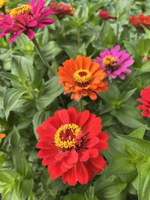Dakota Gardener: Joyful zinnias
(Click an image below to view a high-resolution image that can be downloaded)
By Carrie Knutson, horticulture agent
NDSU Extension – Grand Forks County
I have a few flowers on my list that make me happy. They are flowers that must be cut and brought into the house. One is a spring flower, peonies, and one is a summer or fall flower, zinnias.
Zinnias are a member of the Asteraceae or Composite family, the same family in which sunflowers belong. The leaves are arranged opposite on the stem and do not have a petiole attaching the leaves to the stem. Instead, the leaves clasp around the stem.
The flower heads can be large up to 6 inches across in some cultivars or as small as a 1 inch in other cultivars.
Let’s talk about the flower characteristics of composite flowers to help you understand the difference in flower types of zinnia flowers.
Think of a sunflower with the bright yellow petals around the outside and the dark center. The flowers with the eye-catching petals on the outside are called ray flowers. The flowers in the center are called disk flowers. The disk flowers are not as flashy as the ray flowers, but that does not mean they are not important. The disk flowers are the main attraction for pollinators.
Back to zinnia flowers: flowers can be single, double or semi-double. Single flower zinnias only have one row of petals. Ray flowers, with a center filled with disk flowers, are great for pollinators.
Double flowers have multiple rows of ray flowers with a small center, not so attractive to pollinators. Semi-double flowers have multiple rows of ray flowers, and the center or disk-flower size can vary with the cultivar. Therefore, its size affects a flower’s attractiveness to pollinators. Double and semi-double zinnia flowers are bred to have more ray flowers at the expense of the nectar- and pollen-producing parts of the plants.
In the landscape, zinnias are an annual bedding plant. The plants grow upright and their height can vary depending on the cultivar.
They can easily be direct-seeded or purchased as transplants from greenhouses. While I have had trouble with transplanted zinnias, the ones I direct-seed never disappoint.
Plant zinnias in full sun with good air circulation. They like hot, dry weather - the drier the better. Diseases like powdery mildew, and root and stem rot can affect the plants.
One note of caution, if you like to over-water plants, zinnias are not for you. I have killed a few plantings of zinnias by caring for them too much. I learned the hard way that they are best left alone.
Zinnias are truly a joyful flower. I suggest adding them to your planting list for next year. You won’t regret it. Happy gardening!
NDSU Agriculture Communication – Oct. 4, 2022
Source: Carrie Knutson, 701-780-8229, carrie.knutson@ndsu.edu
Editor: Kelli Anderson, 701-231-6136, kelli.c.anderson@ndsu.edu




